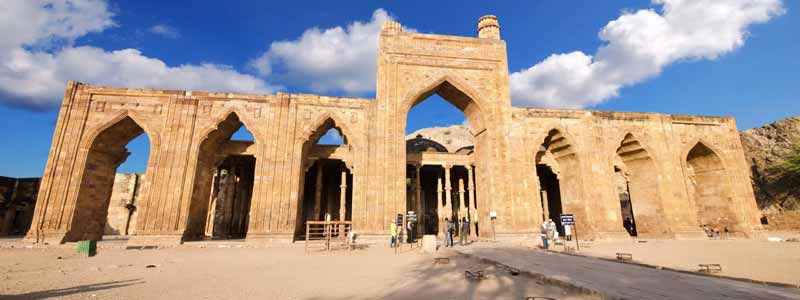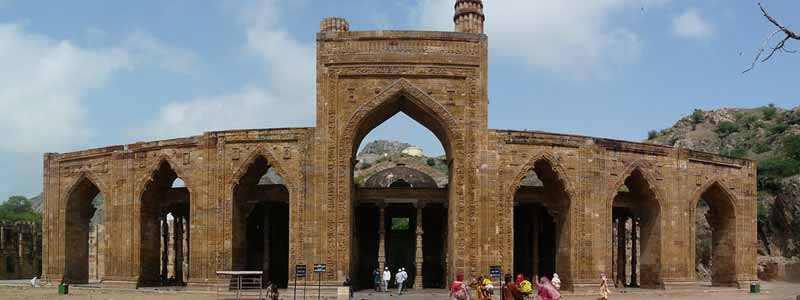Adhai Din Ka Jhonpra is a mosque located in Ajmer, Rajasthan and is considered as one of India’s oldest Mosques present till date. This mosque originally was a Saraswati Temple and a Sanskrit college, but during the Tarain Battle and the invasion, the temple and the college were destroyed and then were converted into a Mosque. The mosque was founded in the 1192 CE by Muhammad Ghori. There are different meanings behind the name ‘Adhai Din Ka Jhonpra‘, some say due to the fact that the mosque was constructed within 2 and a half days, the name was decided as Adhai Din Ka Jhonpra.
But there are people, especially the Sufi’s who claim that the name ‘Adhai Din Ka Jhonpra’ refers to the temporary life of a human on earth. The Adhai Din Ka Jhonpra Mosque was built according to the Mamluk dynasty architecture and was built out of the remaining materials of the Saraswati temple and the Sanskrit college. Therefore there were a few features of Hindu and Jain religion here and there but the gods and goddesses were removed from the remaining materials. Till 1947, i.e. when India got the Independence, ‘Adhai Din Ka Jhonpra’ was used as a mosque and was later taken over by the Archaeological Survey of India (ASI) who are protecting and maintaining the Mosque in the city.

Facts
- There are seven arches in this building. These arches are unique examples of Hindu-Muslim architecture.
- It is situated at a short distance from Khwaja Moinuddin Chishti Dargah.
- In this ruined building, 7 arches and 70 pillars of Hindu-Muslim workmanship have been made and magnificent work has been done on the roof as well.
- Many things are prevalent from this and now every year a fair of two and a half days is held here.
- Its name is due to the construction of this two-and-a-half day hut.
- Earlier there was a very big Sanskrit school here.
- In 1198, Muhammad Ghori converted that school into a mosque.
- Its map was prepared by Abu Bakr.
- The inner part of the mosque looks like a temple apart from the mosque.

History of Adhai Din Ka Jhonpra
It is said that the mosque is a construction which is made from the remains of the Sanskrit college which was made by Vigraharaja IV who was also known as Visaladeva and was a king of the Shakambhari Chahamana (Chauhan) dynasty. A temple dedicated to Goddess Saraswati was located inside the temple.
But the original and ancient building was demolished by Qutub Ud-din-Aibek and it was done in 12th century. And the orders were given by Mohammad Ghori when he defeated Prithviraj III in the second battle of Terain. The mosque was named as Adhai Din Ka Jhonpra means a hut made in two and a half days.
This mosque was ignored for many years by the kings of Rajasthan and after seeing the ignorance the Archeological Survey of India but the famous Maratha leader Daulat Rao Sindhia restored the central dome of the mosque, and forced the locales to stop the removal of stones from the structure.
And this incident is also mentioned in an inscription named Saavan encouraging the Hindus and Muslims not to remove stones from the ancient building.
The Archeological Survey of India has managed and kept this place in a good condition that make the place one of the best tourist attractions of Ajmer Tour Packages and also maintained its architecture well.
Mosque Architecture
The mosque is among the earliest examples of the Indo-Islamic architecture. It was designed by Abu Bakr of Herat, an architect who accompanied Muhammad Ghori. The mosque was built almost entirely by Hindu masons.
The exterior of the building is square-shaped, with each side measuring 259 feet. There are two entrances, one at the south, and another at the east. The prayer area (the actual mosque) is located in the west, while the north side faces a hill rock.
The actual mosque building on the western side has 10 domes and 124 pillars; there are 92 pillars on the eastern side; and 64 pillars on each of the remaining sides. Thus, there are 344 pillars in the entire building. Out of these, only 70 pillars remain standing now.
The main arch is nearly 60 feet high, and is flanked by six smaller arches. The arches have small rectangular panels for passage of daylight, similar to the ones found in early Arabian mosques.
How To Reach
By Air: The nearest airport to Ajmer is Jaipur, the capital of Rajasthan. From there, you can avail local cabs or private taxis that will take you to Ajmer.
By Train: Ajmer is linked by train from all the major cities of India. The best option is to catch a train from Delhi. There are trains like Shatabdi Express, The Pink City Express and Chetak Express that will take you easily to Ajmer.
By Road: Ajmer is well connected by a good network of roads from Delhi, Agra and other major cities of Rajasthan. So finding a public road transport won’t be difficult.
Adhai-din-ka-Jhonpra is a sacred site for the Muslims. This mosque stands as a fine example of Indo-Islamic architecture. It relays the history of Mughal emperors and is one of the best places to visit in Ajmer because of its historical and spiritual relevance.
